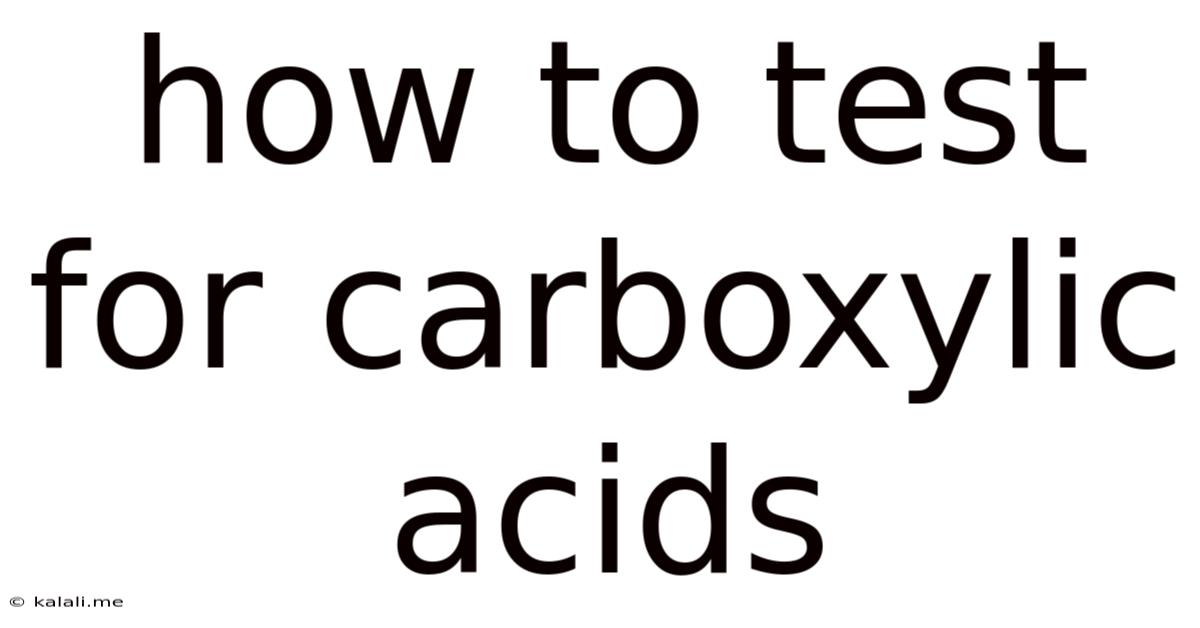How To Test For Carboxylic Acids
Kalali
Jun 11, 2025 · 3 min read

Table of Contents
How to Test for Carboxylic Acids: A Comprehensive Guide
Carboxylic acids are a fundamental class of organic compounds characterized by the presence of a carboxyl group (-COOH). Identifying the presence of this functional group is crucial in organic chemistry, and thankfully, several reliable tests exist. This article will guide you through various methods for testing for carboxylic acids, explaining the underlying chemistry and providing practical tips for accurate results. Learn how to differentiate carboxylic acids from other functional groups and confidently identify them in your experiments.
Understanding Carboxylic Acid Properties: Before diving into the tests, it’s essential to understand the properties that make these tests effective. Carboxylic acids are weak acids, meaning they partially dissociate in water to release H⁺ ions. This acidic nature forms the basis of many identification tests. Their acidic nature also affects their solubility and reactivity, influencing how they interact with different reagents.
1. Litmus Paper Test: A Simple Initial Screening
This is the simplest and quickest test. Carboxylic acids will turn blue litmus paper red, indicating their acidic nature. While a positive result suggests the presence of an acid, it doesn't definitively confirm a carboxylic acid. Other acidic functional groups, like phenols and sulfonic acids, will also produce the same result. Therefore, this test acts as a preliminary screening, guiding you toward further, more specific tests.
2. Sodium Bicarbonate Test (NaHCO₃): Distinguishing Carboxylic Acids from Weaker Acids
The reaction of carboxylic acids with sodium bicarbonate produces carbon dioxide gas (CO₂), which is easily observed as effervescence. This test helps differentiate carboxylic acids from weaker acids like phenols. Add a small amount of the unknown compound to a solution of sodium bicarbonate. The evolution of bubbles confirms the presence of a carboxylic acid. The reaction is shown below:
RCOOH + NaHCO₃ → RCOONa + H₂O + CO₂
3. Sodium Carbonate Test (Na₂CO₃): A More Vigorous Reaction
Similar to the bicarbonate test, sodium carbonate also reacts with carboxylic acids, producing carbon dioxide gas. However, this reaction is generally more vigorous than the bicarbonate test due to the higher basicity of sodium carbonate. This test offers another way to confirm the presence of a carboxylic acid and can be particularly useful if the bicarbonate test yields ambiguous results.
4. Neutralization with Bases: Titration for Quantitative Analysis
Titration with a strong base, such as sodium hydroxide (NaOH), allows for quantitative determination of the carboxylic acid concentration. By carefully measuring the volume of base needed to neutralize a known amount of the acid, you can calculate its molar mass and concentration. This is a crucial technique for precise analysis and is widely used in various analytical chemistry applications.
5. Formation of Derivatives: Confirming Structure and Properties
Several derivatives can be prepared from carboxylic acids, providing further confirmation of their identity. These include:
- Amides: Reaction with ammonia or amines produces amides, characterized by their high melting points and often crystalline structure.
- Esters: Reaction with alcohols in the presence of an acid catalyst forms esters, characterized by their often pleasant aromas.
- Acid Chlorides: Reaction with thionyl chloride (SOCl₂) produces acid chlorides, highly reactive compounds used in various synthetic procedures.
6. Spectroscopic Techniques: Advanced Identification
Modern spectroscopic techniques provide definitive confirmation of the presence and structure of carboxylic acids. These include:
- Infrared (IR) Spectroscopy: Carboxylic acids exhibit characteristic absorption bands in the IR spectrum, particularly a broad peak around 3000 cm⁻¹ (O-H stretch) and a strong peak around 1700 cm⁻¹ (C=O stretch).
- Nuclear Magnetic Resonance (NMR) Spectroscopy: ¹H NMR and ¹³C NMR provide detailed information about the structure of the molecule, including the presence of the carboxyl group and its neighboring atoms.
By employing a combination of these tests, you can effectively and confidently identify the presence of carboxylic acids in your samples. Remember to always handle chemicals with care and follow appropriate safety procedures. The choice of test will often depend on the specific context and the level of detail required.
Latest Posts
Latest Posts
-
Four Letter Word With Second Letter A
Jul 01, 2025
-
How Many 1 8 Cups Are In 2 3 Cup
Jul 01, 2025
-
How Many Slices Of Turkey In 2 Oz
Jul 01, 2025
-
Omnipoint Miami E License Llc Miami Fl
Jul 01, 2025
-
Mi Familia Fuera La M S Grande Correct Incorrect
Jul 01, 2025
Related Post
Thank you for visiting our website which covers about How To Test For Carboxylic Acids . We hope the information provided has been useful to you. Feel free to contact us if you have any questions or need further assistance. See you next time and don't miss to bookmark.